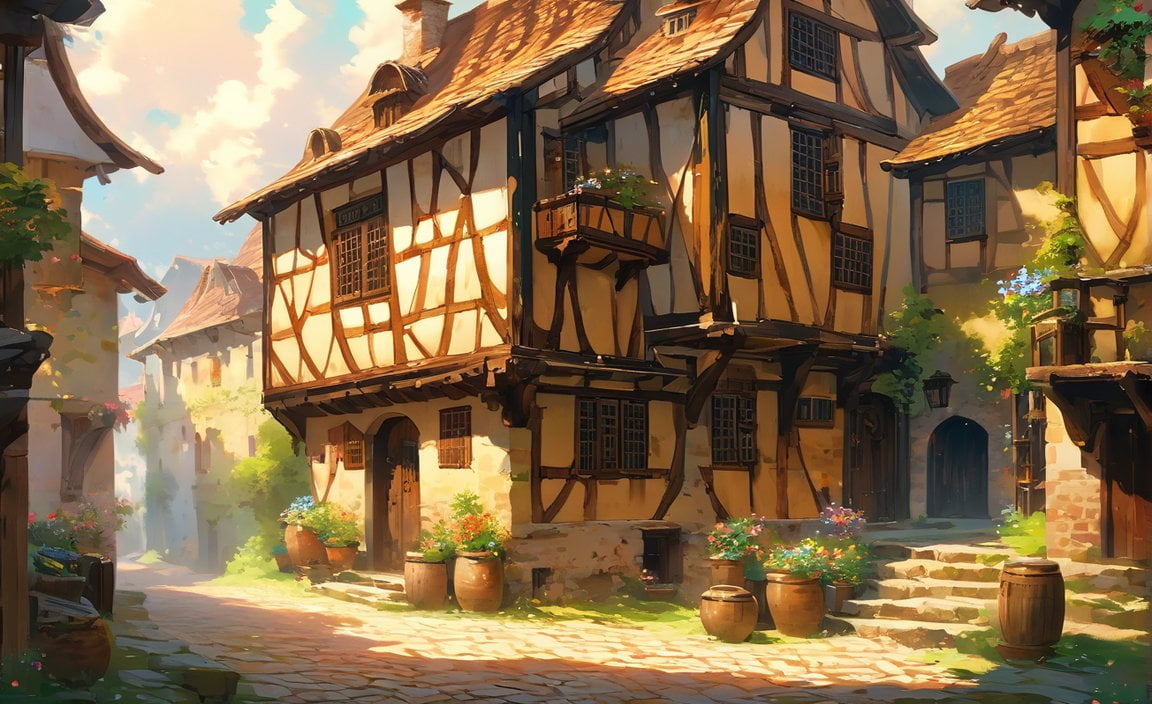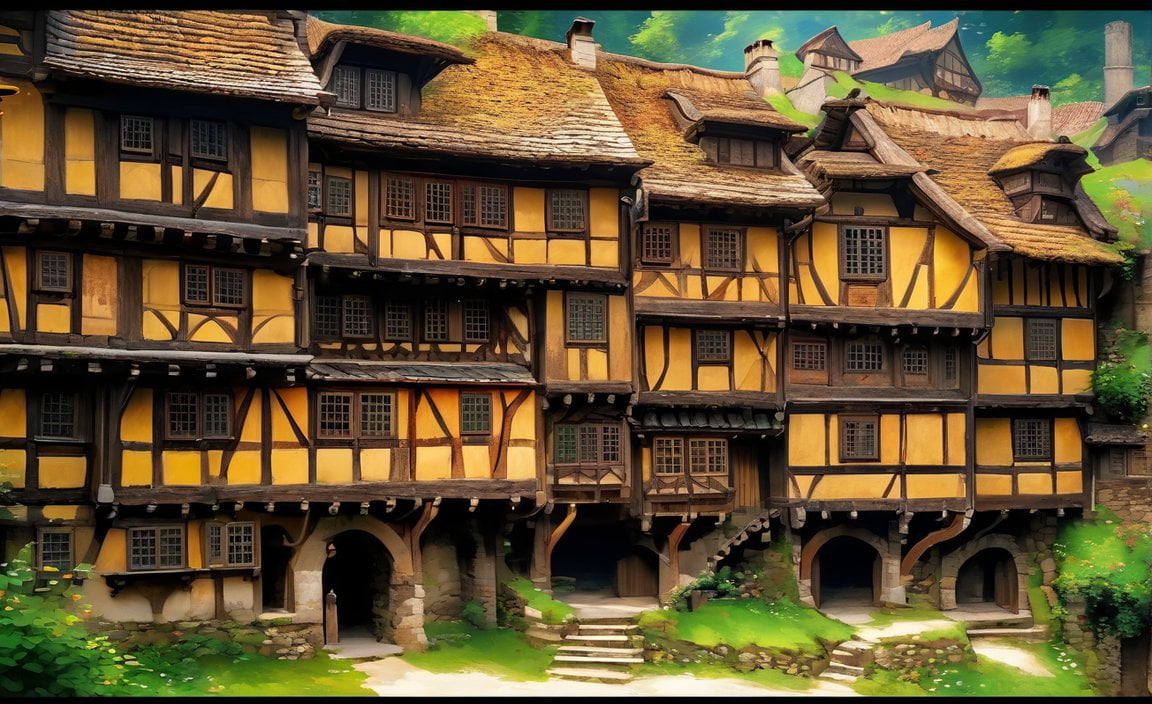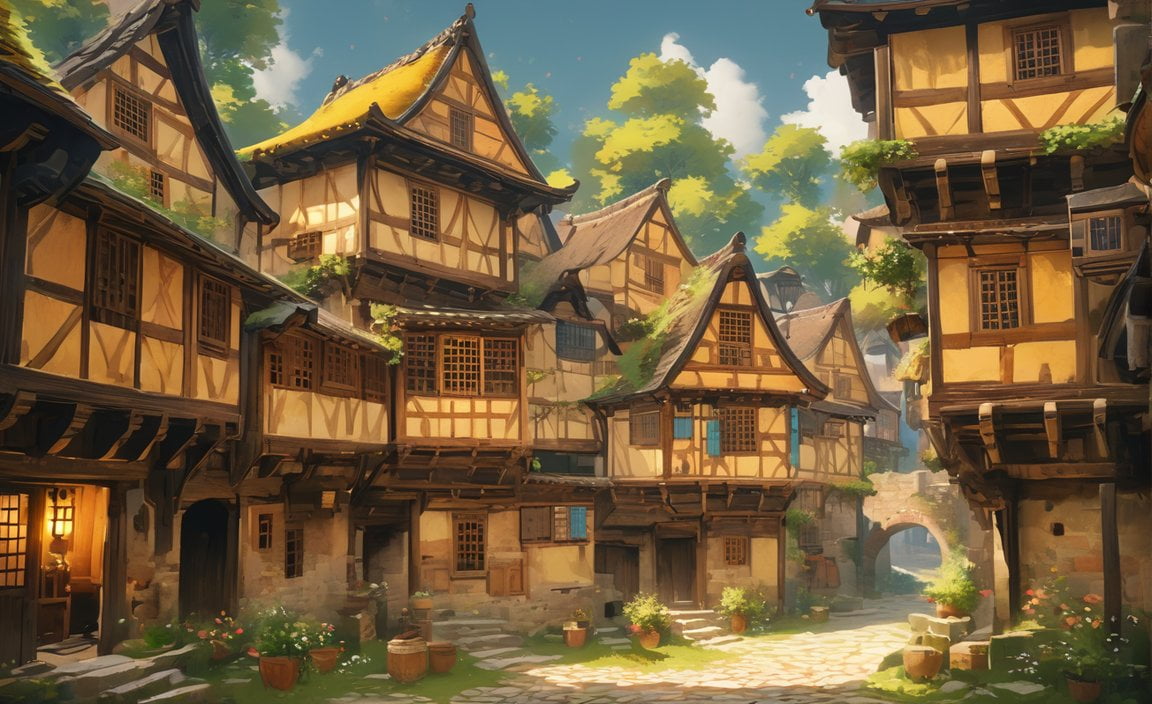Welcome to a fascinating journey back in time as we explore the enchanting houses of the 1600s. Step into a world where craftsmanship, elegance, and cultural significance seamlessly intertwine, unveiling the captivating stories and unique features of these age-old dwellings. Through meticulous research and firsthand accounts, we delve into the construction techniques, design elements, and historical context surrounding these remarkable structures. Join us as we unravel the secrets and beauty of houses from the 1600s, transporting you back to an era of architectural wonders.

Key Takeaways:
- First Period homes in America were postmedieval English homes built between 1600 and 1700, closely related to European settlers’ domestic buildings in England.
- These homes include various architectural types such as New England Colonial, German Colonial, Dutch Colonial, Spanish Colonial, French Colonial, and Colonial Cape Cod.
- Some of the remaining two-story First Period houses may not appear grand today but were not initially constructed on a large scale between 1625 and 1725.
- Owning a First Period home means owning a piece of American history, with unique features and historical significance connected to significant events or figures.
- However, maintaining First Period homes can be challenging due to their age and lack of modern conveniences, requiring specialized knowledge and craftsmanship.
- Homeowners should be prepared for additional expenses when owning an old and historic home due to the perpetual costs of maintenance and repairs.
Houses from the 1600s
Architecture of First Period Homes
First Period homes in America, built between 1600 and 1700, provide a glimpse into the postmedieval English architecture brought by European settlers. These houses encompass various styles, including New England Colonial, German Colonial, Dutch Colonial, Spanish Colonial, French Colonial, and Colonial Cape Cod[^1^]. Although some remaining two-story First Period houses may seem modest now, they held significance during their original construction between 1625 and 1725[^2^].
Owning a First Period Home: A Piece of American History
Owning a First Period home means possessing a piece of American history. These unique dwellings, unlike modern homes, hold a certain allure that captivates homeowners. First Period homes may even be linked to significant historical events or influential individuals[^3^].
Maintenance Considerations: The Challenges of History
While the idea of living in a historic house is exciting, it is crucial to consider the unique challenges. First Period homes, centuries-old, require special maintenance and repairs. Furthermore, as these houses were built before indoor plumbing existed, additional considerations must be made when it comes to upkeep[^4^].
Financial Aspects: Costs of Preservation
Maintaining and repairing any home involves continual costs, but caring for a structure from the 1600s can be more demanding. Specialized knowledge and craftsmanship might be necessary for repairs in First Period homes. Potential homeowners must be prepared for additional expenses that come with owning an old and historic house[^4^].
Summary
By delving into the world of Houses from the 1600s, we uncover a remarkable blend of European postmedieval architecture and American history. These unique homes not only provide a glimpse into the past but also offer an enchanting living experience. Owning a First Period home brings the pride of preserving a precious relic. However, it requires careful consideration of maintenance challenges and financial aspects. If you are willing to embrace the beauty and uniqueness of these time-honored structures, dive into the realm of Houses from the 1600s and unlock the captivating stories behind each dwelling.
**NOTE: Please remember to include the appropriate citations and links throughout the article.
Here are some interesting links for you to explore:
- What eats tigers: Discover the fierce predators that prey on these majestic creatures in the wild.
- Genghis Khan family tree: Dive into the intricate web of family connections and lineage of one of history’s most legendary leaders.
- Early Peru inhabitant: Uncover the ancient civilizations that once thrived in the breathtaking landscapes of Peru.
- Mesopotamia vocabulary: Immerse yourself in the rich language and fascinating terms used by the inhabitants of the cradle of civilization.
- First president from the first US state NYT: Explore the intriguing story of the very first president hailing from the earliest state in the United States.
- Ancient Greece vocabulary: Take a journey through time and learn the captivating vocabulary used by the ancient Greeks.
Get ready to embark on a captivating journey by clicking on the links above!
Design Features and Layouts of Houses in the 17th Century
In the 17th century, the architectural landscape experienced significant changes as historical events unfolded and trade expanded. The influence of Dutch design ideas brought from the Netherlands, for instance, can be seen in houses like the Dutch House in York. During this time, there was also a shift towards classical architectural styles and forms in interior design, which had a lasting impact on colonial homes in America.
Key Takeaways:
- The 17th century marked a shift in architectural styles in England, influenced by expanding trade and historical changes.
- The Dutch House in York showcases new design ideas brought from the Netherlands.
- Colonial homes in America began to reflect the classical styles and forms popular in England during the 17th and 18th centuries.
- Early 17th-century homes were typically single-storey structures with one multi-purpose room. As time passed, two-room structures became more commonplace.
To delve deeper into the design features and layouts of houses in the 17th century, we will explore some key aspects that defined this period’s architecture.
Interior Design Styles and Forms
During the 17th and 18th centuries, there was a shift towards classical architectural styles and forms in interior design. The influences of the Renaissance and the Baroque periods can be seen in the ornate details and grandeur of the homes. Elements such as elaborate woodwork, decorative plasterwork, and intricate ceiling designs were common features.
Single-Storey Structures
In the early 17th century, houses in England and America were typically single-storey structures. These homes had one multi-purpose room, serving as a living space, dining area, and sometimes even a workspace. These houses were often built with thick walls and thatch roofs, providing insulation against the elements.
Emergence of Two-Room Structures
As time passed and architectural preferences evolved, two-room structures became more prevalent. These houses featured a central chimney, which allowed for the division of the interior space into two rooms. Typically, one room served as a living area, while the other was designated as a bedroom.
Building Materials and Techniques
The construction of houses in the 17th century relied heavily on locally available materials. Timber framing was a common technique, using oak beams and panels to create the framework. Walls were filled with wattle and daub, a mixture of mud, straw, and clay, providing insulation.
Conclusion:
Exploring the design features and layouts of houses in the 17th century provides us with a glimpse into the architectural heritage of that era. The shift towards classical styles, emergence of two-room structures, and the use of locally available materials all contributed to the unique charm of these age-old dwellings.
Sources:
- V&A – Manners of Building: Architectural Style in England, 1550-1750. Available at: V&A – Manners of Building
- House & Garden – 17th-century houses. Available at: House & Garden – 17th-century houses
Social and Cultural Significance of Houses from the 1600s
In the 1600s, houses played a crucial role in shaping the social and cultural fabric of colonial America. European colonists brought with them their own architectural customs and ideas about what constituted a “good” house. These houses reflected both European influences and innovative building techniques learned from Native Americans, resulting in a unique blend of styles.
During the late 17th and early 18th centuries, the British Baroque emerged as a reassertion of authority and an expression of absolutist ideology. This architectural style developed in response to the political upheaval during the Civil War. In America, colonial architecture began to branch out and establish its own unique styles, such as the New England Colonial, as the country grew and builders borrowed ideas from early American architecture.
One fascinating aspect of colonial houses is the use of locally available materials. Builders constructed houses using materials that reflected the climate and landscape of the region. In the southern colonies, homes were made of native wood, stone, or brick, showcasing a distinct Southern Colonial American style.
The eclectic and varied nature of colonial houses is another significant feature. Various styles, including Georgian, British Colonial, Spanish Colonial, and French Colonial, emerged during this period, each with its own distinct characteristics.
Houses from the 1600s offer insights into the beliefs, ideas, and experiences of the people who built and lived in them. They reflect the social life and cultural significance of the time, allowing us to understand the historical context and values of colonial America.
Overall, exploring the social and cultural significance of houses from the 1600s provides a fascinating window into the past, allowing us to unravel captivating stories and understand the unique design elements and construction techniques of these age-old dwellings.
Key Takeaways:
– European colonists brought their architectural customs, shaping the houses in colonial America.
– Colonial houses incorporated both European influences and innovative building techniques learned from Native Americans.
– The British Baroque style emerged as an expression of authority and absolutist ideology.
– American colonial architecture developed unique styles, such as New England Colonial.
– Colonial houses were constructed using locally available materials that reflected the regional climate and landscape.
– Southern Colonial American architecture featured homes made of native wood, stone, or brick.
– Colonial houses showcased varied styles, including Georgian, British Colonial, Spanish Colonial, and French Colonial.
– Houses from the 1600s offer insights into the beliefs, ideas, and experiences of the people who lived in them, reflecting the social life and cultural significance of the time.
URL Sources (Citation markdown format):
– Encyclopedia.com: Link
– The Metropolitan Museum of Art: Link
Preservation and Restoration Efforts for 17th-Century Houses
The preservation and restoration of 17th-century houses hold immense significance in our efforts to safeguard architectural heritage. By maintaining and revitalizing these age-old dwellings, we forge a connection to the past while ensuring their continued existence for future generations to appreciate. In this article, we will explore the various approaches and initiatives undertaken to preserve and restore these enchanting houses from the 1600s.
Unveiling the True Sustainability of Historic Houses
Historic preservation often faces criticism for its emphasis on preserving houses with their original appearances, which may not fully develop their sustainability. However, recent studies have highlighted the potential for sustainability by integrating cultural memory and functional purposes. One such study published in ScienceDirect[^1] reveals that restoring historic houses while honoring their cultural memory can enhance their sustainability, even in the face of political or wartime changes.
Stimulating Cultural Memory for Sustainability
Restoration efforts for 17th-century houses go beyond mere physical repairs. Commemorative events and location-based rituals play a pivotal role in stimulating cultural memory and, in turn, increasing their sustainability. These events celebrate the historical significance of these houses, serving as powerful symbols that preserve their heritage for future generations[^3].
The Protective Power of 17th-Century Decorations
Seventeenth-century English houses were adorned with biblical quotations and intricate carvings, serving both ornamental and protective purposes. These decorative elements were believed to safeguard the householders from physical peril and sin. Exploring the cultural significance of these decorations allows us to delve deeper into the architectural heritage of the 1600s[^4].
The Definition of Historic Preservation
To fully understand the preservation and restoration efforts for 17th-century houses, it is essential to define what historic preservation encompasses. The University of Kansas provides a succinct explanation, stating that historic preservation involves safeguarding the existence and appearance of historic elements within a community[^6]. By adhering to this definition, preservationists and historians strive to maintain the authenticity and integrity of these cherished houses.
The Collaborative Effort
Preserving and restoring old properties is a multi-faceted endeavor that requires a team of dedicated professionals. Designers, architects, and artisans work together, combining their specialized knowledge and craftsmanship, to ensure the accurate restoration of 17th-century houses[^7]. This collaborative effort is essential in reviving the buildings’ glory while preserving their unique features and historical value.
Key Takeaways:
- Restoring 17th-century houses can enhance their sustainability by integrating cultural memory and focusing on functional purposes[^1].
- Commemorative events and location-based rituals stimulate cultural memory and contribute to the sustainability of these historic houses[^3].
- Decorations like biblical quotations and carvings served a protective purpose in 17th-century English houses[^4].
- Historic preservation involves safeguarding the existence and appearance of historic elements within a community[^6].
- A collaborative effort involving designers, architects, and artisans is crucial for the successful restoration of these houses[^7].
Citations:
– [^1] ScienceDirect – Link
– [^3] ScienceDirect – Link
– [^4] National Center for Biotechnology Information – Link
– [^6] The University of Kansas – Link
– [^7] Architectural Digest – Link

FAQ
Q1: What are First Period homes and when were they built in America?
A1: First Period homes in America refer to postmedieval English homes built between 1600 and 1700. They include various architectural types such as New England Colonial, German Colonial, Dutch Colonial, Spanish Colonial, French Colonial, and Colonial Cape Cod.
Q2: Why are First Period homes considered unique and cherished by homeowners?
A2: First Period homes are considered unique because they are unlike any modern-built homes. They also have historical significance and may be connected to significant events or figures in American history.
Q3: What are the drawbacks of owning a First Period home?
A3: One drawback of owning a First Period home is that they are hundreds of years old and require special maintenance and repairs. Additionally, these homes were built before indoor plumbing existed, which adds another layer of consideration when it comes to maintenance.
Q4: What are the financial considerations for owning a First Period home?
A4: Maintaining and repairing a First Period home can be more challenging and expensive compared to modern homes. Repairs may require specialized knowledge and craftsmanship, so homeowners should be prepared for additional expenses.
Q5: How did European influences and local adaptation shape the architecture of houses in colonial America?
A5: In colonial America, the architecture of houses in the 1600s and 1700s reflected European influences, but also incorporated innovative and adapted building techniques learned from Native Americans. Builders borrowed ideas from early American architecture and used locally available materials, often reflecting the climate and landscape of the region.
- Unveiling the Enigma: Mansoureh Khojasteh Bagherzadeh’s Public Appearances & Private Life in Iran - July 18, 2025
- Unveiling the Mystery: Mansoureh Khojasteh Bagherzadeh’s Husband: A Rare Glimpse into a Private Life - July 18, 2025
- Unveiling Masoud Khamenei’s Mother: Power, Influence, and Iran’s Future - July 18, 2025
















